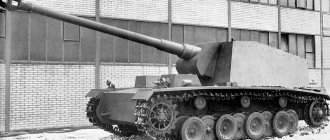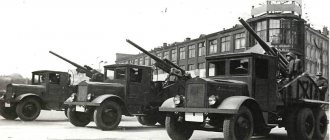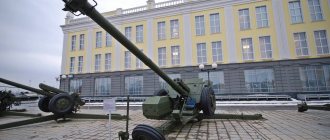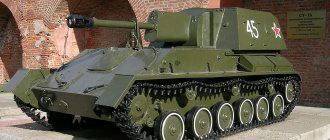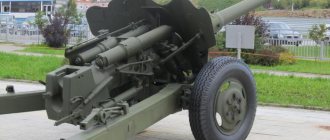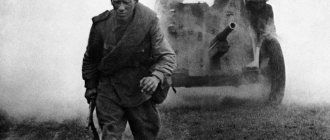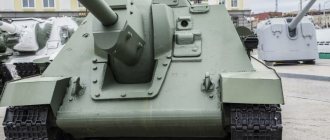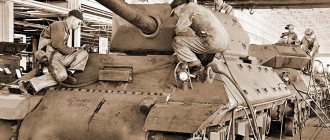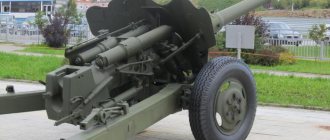Stories about weapons. 57-mm anti-tank gun ZiS-2
There are two versions of the birth of this gun.
The first says that the task for the development of a new anti-tank gun by the design bureau under the leadership of V.G. Grabin received in 1940, shortly after the end of the Soviet-Finnish war.
The Soviet command hoped that the use of heavy tanks with projectile-proof armor by the Red Army would not go unnoticed, and the creation of similar vehicles would begin among potential enemies.
The KV (later KV-1) and KV-2 tanks with 75-95 mm armor were taken as the basis.
The second version: the Germans “fed” our intelligence misinformation about the imminent appearance of tanks with shell-proof armor from 60 to 80 mm.
Research carried out at the Grabin Design Bureau showed that the optimal caliber for such a weapon would be 57 mm with a projectile weighing 3.14 kg with an initial speed of 1000 m/s.
At the beginning of 1941, such a weapon was created. At a distance of 500 m, the shell penetrated armor 100 mm thick. In May 1941, the development of the technology for its production was completed, and the weapon adopted for service by the Red Army was put into full production simultaneously at artillery factories in Stalingrad and Gorky.
Until the end of 1941, 371 ZiS-2 guns were produced, and then their production was discontinued “due to excess power in the absence of appropriate targets.”
And this is where things get weird.
In general, several reasons were given. The removal of the ZiS-2 was explained by the following reasons:
1. Excessive power of the gun and lack of urgent need for it. The thickness of the frontal armor of German armored vehicles in 1941 did not exceed 60 mm, and the side armor - 40 mm. Under these conditions, the effectiveness of the 45-mm and 76-mm guns, which were well mastered in mass production, was sufficient. Allegedly, the ZiS-2 “sewed” German tanks right through, without causing damage to them.
Let's just say it's a very strange argument. And here's why: in order to appreciate it, you just need to look inside any tank. The tank seems to consist not only of frontal and side armor; it also has many more components inside. Engine, transmission, weapons, ammunition, turret rotation mechanism, crew... In general, there is something to grab hold of, no matter how you look at it. This is not a laser, but a projectile after all.
Yes, it was possible to break through “side-to-side” under certain circumstances. But it was like the stars were supposed to align...
2. Low technology and high cost of the weapon.
Also highly contested. The ZiS-3 76-mm cannon was recognized as one of the best in the world in terms of all its characteristics. Including ease of manufacture and manufacturability.
But excuse me, when creating the ZiS-3, the carriage and bolt from the ZiS-2 were used. What to do with this? What's left there? The swinging part from the USV cannon and the barrel. Let's just say it's not a very compelling argument.
3. Stalingrad was overloaded with the production of 76-mm USV divisional guns, due to which the plant was forced to stop producing ZiS-2 barrels, and plant No. 92 could not cope with the production of barrels.
Also strange. Didn't cope or didn't release at all? Where were Beria’s brave boys? In 1941, for failure to produce such products, they could even find a wall in the factory yard, without bothering with delivery.
And then, if we lost during the battles for Stalingrad, apparently, with the wave of a magic wand, everything got better in 1943. But I don’t rule out that during the two war years, Plant No. 92 finally mastered the production of barrels. This is much easier to do in wartime than in peacetime.
4. Problems with the production of ammunition - the production of 57-mm shells was not previously carried out in the USSR; the deployment of their production after the start of the war was fraught with a number of difficulties associated, in particular, with the evacuation of the ammunition production plant.
However, despite the existing difficulties, the fired guns (a total of 371 units) were provided with ammunition:
- in 1941, 310 thousand 57-mm rounds were supplied to the troops; - in 1942 - another 82 thousand shots; — on January 1, 1943, there were still 220 thousand rounds available.
In 1942, the troops used 50.5 thousand 57-mm shells. in 1943 - 76 thousand shells (for comparison, the consumption of shells for 45-mm anti-tank and tank guns during the same period was more than 12 million pieces). In 1944, 460.3 thousand 57-mm shells were used.
In 1945, 580.1 thousand 57-mm shells were used.
Apparently, the shells were also in order.
In general, the reason for the discontinuation of the ZiS-3 is still not entirely clear. I am more inclined to the third point, it seems to be the most adequate.
But in 1943, with the advent of German tanks with shell-proof armor, the gun was put into production again.
The ZiS-2 was used in anti-tank artillery platoons of rifle battalions and in individual anti-tank fighter units of the Russian Civil Command.
By the way, these guns began to arrive in the Red Army three weeks after the adoption of the corresponding resolution of the State Defense Committee. It is clear that the reserves of 1941 were used, nevertheless. The problems disappeared somewhere, and the gun went to war with the Tigers.
Total in 1943-1945. 9,645 ZiS-2 anti-tank guns were manufactured.
A little? There is an obvious issue of efficiency here. If, when using a 45-mm anti-tank gun, the crew had to pervert, guessing where and how the enemy would come from in order to shoot at his side, often sacrificing for this a good position and unmasking himself with the first shot, then in the case of a 57-mm anti-tank gun there were no such problems .
The “didn’t penetrate” option was not for the ZiS-2, all that remained was to stick it not where it was possible, but where it was necessary.
According to statistics, for one disabled 57-mm cannon there were three destroyed enemy tanks, while for 76-mm - 2.5, and for 45-mm - 0.25.
That's the whole deal, as they say.
The ZiS-2 cannon is a classic long-barreled anti-tank gun for artillery during the Second World War with sliding frames, a semi-automatic wedge breech and sprung wheel travel.
Structurally, the gun is divided into a barrel with a bolt and a carriage. The latter, in turn, consists of recoil devices, a cradle, an upper machine, aiming mechanisms, a balancing mechanism, a lower machine, a combat move with suspension, a shield cover and sighting devices.
The suspension consists of two helical springs placed in cylinders at the ends of the combat axle. The suspension is switched off automatically when the frames are extended.
The PP1-2 sight with a hinge drive was used as sighting devices.
The gun is equipped with a bolt with a downward wedge and a semi-automatic mechanical (copier) type. Only for the first loading you need to open the shutter manually using the shutter handle; then it closes and opens automatically.
This bolt design ensured a high rate of fire for the gun - up to 25 rounds per minute.
The cannon can be fired at a maximum elevation angle of 25°, a declination angle of 5°, and a horizontal firing angle of 54°.
The following unitary cartridges were used to combat armored targets:
— a unitary cartridge with an armor-piercing tracer blunt-headed projectile with a ballistic tip BR-271; — a unitary cartridge with an armor-piercing tracer sharp-headed projectile without a ballistic tip BR-271K; — unitary cartridge with a solid armor-piercing tracer projectile BR-271SP; — a unitary cartridge with a sub-caliber armor-piercing tracer projectile BR-271P.
To fire at enemy manpower and openly located firing points, shells with the O-271U fragmentation grenade were used, which, when the fuse cap is removed, ensures destruction by fragments at 20 m along the front and 3 m in depth. When the fuse cap is not removed, the grenade acts like a high-explosive one.
To defeat enemy personnel at a range of 100-200 m during battery self-defense, Shch-271 buckshot was used. When fired, the shell of the buckshot unfolds in the barrel and 324 bullets weighing 10.8 g each fly forward, having an expansion angle of 10-18°. The affected area with the lethal effect of bullets is up to 40 m along the front, up to 200 m in depth.
Thanks to the presence of suspension, the gun can be transported by mechanical traction at speeds of up to 50 km/h on the highway, up to 30 km/h on country roads and up to 10 km/h off-road. The cannon was also transported by horse-drawn vehicles - six horses.
Ammunition for the gun can be transported both in the back of the vehicle and in the limber, unified with the limber of 76-mm divisional and regimental guns.
In the fall of 1941, about a hundred ZIS-2 guns were also manufactured in a self-propelled version: the swinging part of the gun with a shield cover was installed on the chassis of the Komsomolets tracked tractor. This improvised self-propelled gun was designated ZIS-30. For the first time, 57-mm ZIS-2 mod. guns were available in large quantities. 1943 were used in the summer of 1943 in the battles on the Kursk Bulge.
TTX ZiS-2 model 1943
Caliber, mm: 57 Initial projectile speed, m/s: 700-1250 Maximum elevation angle, degrees: 25 Declination angle, degrees: -5 Angle of horizontal fire, degrees: 54 Weight in firing position, kg: 1250 Rate of fire, rds./ min: up to 25 Longest firing range, m: 8400 Direct shot range, m: 1120 Armor penetration at an impact angle of 60 ° at a distance: - 500 m, mm: 106 - 1000 m, mm: 96
On May 10, 1945, the Soviet Army had about 3,200 57 mm guns, while there were about 23,500 45 mm guns, and about 40,100 76 mm guns.
If we compare the ZiS-2 with its classmates, Pak 39 and Pak 40 (Germany), 6-pdr Mk.II (Great Britain), M1 (USA), there is a superiority of the Soviet gun over its analogues both in calculated armor penetration and in mobility.
The German 50-mm Pak 38 cannon is 120 kg lighter than the ZIS-2, but at the same time it is much inferior to the Soviet gun in initial speed, projectile weight and almost twice as much in estimated armor penetration, and also has a muzzle brake that unmasks the gun when firing.
The English 6-pounder Mk.II cannon is 100 kg heavier than the Soviet one, with a significantly lower initial velocity and a lighter projectile, which results in significantly lower calculated armor penetration. One of the advantages of the English gun is the larger horizontal guidance angle.
The American 57-mm M1 cannon, which is a modification of the English 6-pounder cannon, is even heavier due to its longer barrel. The initial speed increased slightly, but still remained significantly lower than that of the Soviet gun.
In addition, unlike foreign guns, the ZIS-2 is a duplex - the 76-mm ZIS-3 divisional gun was produced on its carriage; the production of two guns using one carriage greatly simplifies and reduces the cost of production.
Even in comparison with a heavier weapon - the German 75-mm anti-tank gun Rak 40, the ZIS-2 also has advantages in armor penetration, calculated according to both Soviet and German methods. In Wehrmacht service, the ZIS-2 was designated as the 5.7-cm Panzerabwehrkanone 208(r) and its penetration properties when fired by the BR-271M projectile were estimated as 140 mm of homogeneous armor when hit along the normal line at a fire distance of 500 meters.
At the same distance and with a small impact angle of relatively 30°, this Pak 40 indicator when using the PzGr.39 caliber armor-piercing projectile was 96 mm, which, in terms of normal impact conditions, gives a thickness of the pierced armor plate of about 120 mm.
Only powerful anti-tank guns that appeared in 1943-1944, such as the British 76-mm QF 17 Pounder weighing more than two tons, the German 88-mm Pak 43/41 weighing more than 4 tons and the 100-mm the Soviet BS-3 weighing more than three tons, as well as the small-scale German 75/50-mm Pak 41 anti-tank gun with a conical bore.
The high characteristics of the ZiS-2 aroused the interest of the Allies, who, at their request, at the end of 1943 were provided with several guns that were tested in the UK and the USA.
A weapon with a woman's name
The range of tasks of the ZIS-3 was very extensive. The gun was intended to destroy enemy infantry, his machine guns and artillery, tanks and armored vehicles, and destroy long-term enemy firing points. At all these targets, the gun fired a varied assortment of cannon shells - from high-explosive fragmentation grenades that pierced a 75-centimeter brick wall, to cumulative shells that burned through the armor of German tanks up to 90 millimeters thick.
Having soon found its way into the active army, the ZIS-3 gun received various nicknames from the artillerymen. Some affectionately called the gun by the feminine name “Zosya” for its reliability and simplicity, while others called it “Volley named after Stalin” for its rate of fire and excellent combat characteristics.
The Germans also awarded the Soviet division a nickname - Ratsch-bumm - due to the fact that the sound of a projectile flying at supersonic speed was heard a little earlier than the roar of the shot.
Hit “tanks” and “panthers” from ambushes
In addition, the ZIS-3 had a very important advantage in anti-tank use - the gun did not bury itself when firing into the ground, like many German guns. This allowed the crew to quickly respond to danger from all sides, and, if necessary, quickly roll the artillery installation after their advancing infantry
With the appearance of “tigers”, “panthers” and heavy self-propelled artillery mounts on the battlefield in 1943, these German armored vehicles turned out to be invulnerable to ZIS-3 fire when firing at the frontal armor. However, Soviet artillerymen began to actively use ambush tactics, shooting the enemy with shots at less protected sides.
After the Red Army introduced sub-caliber and cumulative shells, the anti-tank properties of the ZIS-3 improved, allowing the gun to confidently penetrate 80 mm frontal armor at distances closer than 500 meters. However, the Germans did not have many heavy tanks, and the 76-mm gun dealt with the rest of the enemy armored vehicles perfectly until the end of the war.
German view of the Soviet gun
From the very first days of the ZIS-3's appearance on the battlefield, Wehrmacht soldiers experienced the damaging effects of its fragmentation and shrapnel shells, which were superior to those of foreign guns of similar calibers. Fortunately, the Soviet divisional artillery fired, as a rule, from a short distance of 3-5 kilometers.
As for tanks, before the start of the Kursk Bulge, the ZIS-3 freely hit almost all enemy armored vehicles head-on from a distance of 700-900 meters.
German artillery designers, comparing the technical level of the ZIS-3 with their 75 mm guns, came to the conclusion that the Soviet gun was undoubtedly superior. It was superior to enemy artillery in a number of parameters. In particular, in terms of the ratio of muzzle energy to the weight of the gun in the firing position and at the maximum firing range, moreover, the projectile sent was 13% heavier than the German one.
ammunition
Available Ammo
| Type | model | Weight | Its filling, g |
| Armor-piercing projectile (muzzle velocity up to 990 m/s) | |||
| APhe | BR-271K | 3.14 kg (6.9 lb) | 18 |
| armor-piercing projectile with armor-piercing tip | BR-271 | 3.14 kg (6.9 lb) | 14 |
| Armor-piercing projectile with armor-piercing tip (improved penetration) | BR-271 million | 2.80 kg (6.2 lb) | 13 |
| AP (solid line) | BR-271SP | 3.14 kg (6.9 lb) | nobody |
| Composite armor-piercing projectile (muzzle velocity up to 1250 m/s) | |||
| "Coil" type | BR-271P | 1.79 kg (3.9 lb) | nobody |
| "Smooth" type APCR | BR-271N | 2.4 kg (5.3 lb) | N/A |
| Other projectiles (muzzle velocity up to 700 m/s) | |||
| fragmentation | O-271U (O-271G) | 3.75 kg (8.3 lb) | 204 or 220 |
| canister | Shch.-271 | 3.66 kg (8.1 lb) | nobody |
Armor penetration
| APhe projectile BR-271K | ||
| Distance, m | Angle Meeting 60°, mm | Angle Meeting 90°, mm |
| 100 | 91 | 112 |
| 300 | 84 | 103 |
| 500 | 76 | 94 |
| 1000 | 60 | 74 |
| 1500 | 46 | 57 |
| 2000 | 35 | 44 |
| Armor-piercing projectile with an armor-piercing tip projectile BR-271 | ||
| Distance, m | Angle Meeting 60°, mm | Angle Meeting 90°, mm |
| 100 | 93 | 114 |
| 300 | 89 | 109 |
| 500 | 84 | 103 |
| 1000 | 74 | 91 |
| 1500 | 64 | 79 |
| 2000 | 56 | 69 |
| APCR with BR-271P projectile | ||
| Distance, m | Angle Meeting 60°, mm | Angle Meeting 90°, mm |
| 100 | 155 | 190 |
| 300 | 137 | 168 |
| 500 | 120 | 147 |
| 1000 | 83 | 101 |
| This data was obtained by Soviet methods of measuring armor penetration (75% penetration probability). They are not comparable to Western data of similar type |
service
ZiS-2 were hired by anti-tank artillery platoons of rifle units and anti-tank artillery units of the High Command Reserve, the most numerous of which are anti-tank artillery regiments (Russian fighter Anti-Tank Artillery Regiment, abbreviated IPTAP). The weapons captured by the Germans were given the designation 5.7 cm Pak 208(R)
.
Self-propelled mounts
ZIS-2 model 1943 in Poznan Citadel, Poland.
ZIS-2 was also installed on several vehicles. In 1941, about one hundred ZiS-2 guns were installed on the Komsomolets armored tractor chassis to create the ZiS-30 tank destroyer.
The ZiS-2 pistol was also installed on at least three different prototypes based on the SU-76 assault gun (SU-74, SU-76D and SU-57B). None were accepted for production.
There was also a tank gun version of the ZIS-2 called the ZIS-4. In 1941, in an attempt to improve the anti-tank performance of the T-34 tank, members of Morozov's design bureau experimentally equipped it with a ZIS-4. Only a small number of these T-34-57 tanks were built and used as tank hunters. The idea surfaced in 1943 after the Battle of Kursk because Germany fielded heavily armored Tiger and Panther tanks. Only a limited number of T-34s were produced, equipped with a slightly modified version of the ZIS-4M gun with a new breech to simplify production. Although the high velocity gun had superior armor penetration to the F-34, the light weight of its shell meant that it could not fire an adequate high explosive round for general use. The final solution for the tank was to design a new turret allowing the use of an 85 mm gun; the new model was named T-34-85.
An upgraded version of the ZIS-2 was used in the post-war self-propelled airborne anti-tank gun known as the VRU-57.
History Post-war
Captured ZIS-2, Israel Defense History Museum.
Thanks to improvements in the armor protection of the tank, the ZIS-2 quickly lost its anti-tank role. In Soviet anti-tank artillery forces in the mid-1950s, the ZIS-2 was replaced by a more powerful 100 mm gun. However, its small size and weight kept it in active service with Soviet paratroopers for much longer.
On July 15, 2013, a North Korean ship was intercepted smuggling weapons from Cuba; was found to be carrying ZiS-2 ammunition among other old weapons indicating that some examples remain active in North Korean forces. Before this incident, Namibia was considered the last operator of the ZIS-2; The Namibian Defense Force continued to maintain six examples well into the 1990s. Although no longer in active service, large numbers of ZIS-2 remained in memory as part of the reserve stocks of various national armies around 2008.
The tank that saved Stalin
There is a version according to which the T-34−57, commanded by the famous tank ace Dmitry Lavrinenko, saved Stalin’s life. This happened during the visit of the Secretary General to the 16th Army of General Rokossovsky, which held the defense in the Volokolamsk direction. In particular, Stalin wanted to see the work of the famous Guards Katyusha mortars.
Damaged T-34−57 Photo: wio.ru
On the way back, Stalin’s Packard got stuck in the virgin snow, and the Secretary General had to transfer to an Emka, which also soon stopped.
At this time, Dmitry Lavrinenko’s tank platoon came to the rescue, and just in time, a German SS cavalry division approached the area from which the Katyushas were firing. The Germans could have easily captured two cars with guards, but the appearance of three tanks noticeably cooled their ardor. Stalin was able to return safely to the headquarters of the 16th Army.
By the way, Dmitry Lavrinenko is considered one of the most effective tank crews of the USSR: in a total of 2.5 months of fighting, he was able to knock out 52 enemy tanks, most of which he destroyed with the T-34−57. The brave tankman died on December 7, 1941 - he was struck by a mine fragment during artillery shelling.
